Section 3: Place Making and Design Principles [PDF] - South Norfolk ...
Section 3: Place Making and Design Principles [PDF] - South Norfolk ...
Section 3: Place Making and Design Principles [PDF] - South Norfolk ...
You also want an ePaper? Increase the reach of your titles
YUMPU automatically turns print PDFs into web optimized ePapers that Google loves.
3.3.1 Public Transport<br />
Key principles<br />
Where possible, new development<br />
should be located near to public<br />
transport, to offer people a choice of how<br />
to travel, not only by car.<br />
Depending upon the scale of<br />
development proposals <strong>and</strong> their<br />
potential transport impact, developers<br />
will be expected to contribute towards<br />
improvements to public transport<br />
services <strong>and</strong> facilities, either directly<br />
through s.106 contributions or through<br />
CIL.<br />
Other incentives to reduce the<br />
environmental impacts of cars <strong>and</strong> car<br />
use may also be incorporated into new<br />
development <strong>and</strong> may be regarded as<br />
contributing towards this objective.<br />
Why is it important?<br />
Access to public transport will help to<br />
reduce reliance on the private car <strong>and</strong> so<br />
reduce the environmental impact of new<br />
development. Reducing the number of<br />
car journeys also has the potential to<br />
enhance the experience of pedestrians<br />
<strong>and</strong> cyclists, both in new developments<br />
<strong>and</strong> in existing places.<br />
New development that can be reached<br />
by public transport is also accessible to a<br />
wider group of people than development<br />
that is reliant on car use.<br />
Guidance<br />
Wherever possible, depending upon the<br />
scale of development proposals, access<br />
to public transport should be designed<br />
into the layout. In many cases, this will<br />
involve extending or altering an existing<br />
bus route <strong>and</strong> its stops.<br />
Proposals for bus services must meet<br />
operational requirements, <strong>and</strong> will need<br />
to be agreed with the County Highways<br />
Authority <strong>and</strong> the bus operator, who<br />
should be consulted at an early stage of<br />
the design process.<br />
Bus proposals should:<br />
• serve as many of the occupiers of the<br />
new development as possible;<br />
• provide a direct <strong>and</strong> convenient<br />
route, so that people choose it as an<br />
alternative to the car;<br />
New urban<br />
extension<br />
Village<br />
Existing urban area<br />
• follow a clear route along a principal<br />
street through the development;<br />
• locate stops where activity is<br />
concentrated, near shops, street<br />
junctions, or other pedestrian routes.<br />
Refer also to <strong>Norfolk</strong> County Council’s<br />
‘Safe, sustainable streets: Aims <strong>and</strong><br />
Guidance notes for Local Authority<br />
Highway requirements in Development<br />
Management’ June 2011, at:<br />
http://www.norfolk.gov.uk/view/<br />
ncc099733<br />
Village<br />
A new bus route (red) provided as part of an urban extension improves the public<br />
transport provision for two outlying villages<br />
Main Contents<br />
<strong>Section</strong> 3 Start<br />
3.1 Introduction<br />
3.2 Uses <strong>and</strong><br />
activities<br />
3.3 Accessibility<br />
3.4 Site assets<br />
3.5 Character<br />
3.6 Development<br />
form<br />
3.7 Public realm<br />
3.8 <strong>Design</strong><br />
quality<br />
3.9 Performance<br />
3.10 Worked<br />
example<br />
134


![Section 3: Place Making and Design Principles [PDF] - South Norfolk ...](https://img.yumpu.com/28189284/14/500x640/section-3-place-making-and-design-principles-pdf-south-norfolk-.jpg)
![List of outstanding appeals against planning decisions [PDF, 30 Kb]](https://img.yumpu.com/51294693/1/190x135/list-of-outstanding-appeals-against-planning-decisions-pdf-30-kb.jpg?quality=85)
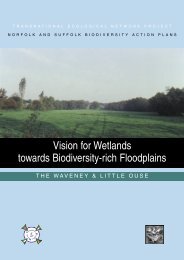

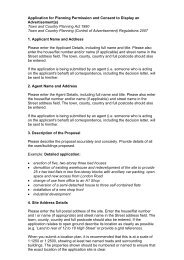
![Brown bin calendar - week 2 [PDF] - South Norfolk Council](https://img.yumpu.com/49352110/1/184x260/brown-bin-calendar-week-2-pdf-south-norfolk-council.jpg?quality=85)
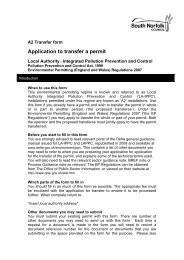

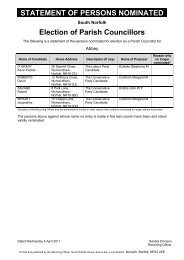
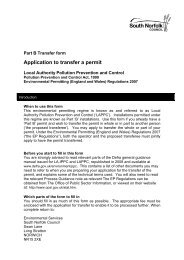
![Link magazine, Spring 2008 [PDF, 4,450k] - South Norfolk Council](https://img.yumpu.com/43994858/1/184x260/link-magazine-spring-2008-pdf-4450k-south-norfolk-council.jpg?quality=85)
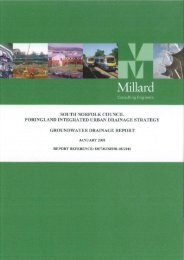
![South Norfolk Council Volunteering Opportunities [PDF]](https://img.yumpu.com/42079564/1/184x260/south-norfolk-council-volunteering-opportunities-pdf.jpg?quality=85)
![Tiffey Valley Guide [PDF, 1,450k] - South Norfolk Council](https://img.yumpu.com/41615145/1/124x260/tiffey-valley-guide-pdf-1450k-south-norfolk-council.jpg?quality=85)
![Queen's Diamond Jubilee Fund [PDF] - South Norfolk Council](https://img.yumpu.com/41088331/1/184x260/queens-diamond-jubilee-fund-pdf-south-norfolk-council.jpg?quality=85)
